Seasonal dynamics of wintering waterbirds in two shallow lakes along Yangtze River in Anhui Province
2011-12-25CHENJinYunZHOULiZhiZHOUBoXURenXinZHUWenZhongXUWenBin
CHEN Jin-Yun , ZHOU Li-Zhi , ZHOU Bo, XU Ren-Xin, ZHU Wen-Zhong, XU Wen-Bin
(1. Institute of Biodiversity and Wetland Ecology, School of Resources and Environmental Engineering, Anhui University, Hefei 230601, China; 2. Life Science Department of Huainan Normal University, Huainan 232001, China; 3. Anqing Waterbird Nature Reserve in Anhui Province, Anqing 246001, China; 4. Shengjin Lake National Nature Reserve, Dongzhi 247200, China)
Seasonal dynamics of wintering waterbirds in two shallow lakes along Yangtze River in Anhui Province
CHEN Jin-Yun1,2, ZHOU Li-Zhi1,*, ZHOU Bo1, XU Ren-Xin1, ZHU Wen-Zhong3, XU Wen-Bin4
(1. Institute of Biodiversity and Wetland Ecology, School of Resources and Environmental Engineering, Anhui University, Hefei 230601, China; 2. Life Science Department of Huainan Normal University, Huainan 232001, China; 3. Anqing Waterbird Nature Reserve in Anhui Province, Anqing 246001, China; 4. Shengjin Lake National Nature Reserve, Dongzhi 247200, China)
The shallow lake wetlands in the middle and lower Yangtze River floodplain are important wintering and stopover habitats for migratory waterbirds on the East Asia-Australia Flyway. With increasing fishery practices in recent years, however, the wetlands have deteriorated significantly and now threaten wintering waterbirds. To gain insight into the influence of deteriorating wetlands on waterbirds, we conducted a survey of wintering waterbird species, population size, and distribution across 11 belt transects in Caizi Lake and Shengjin Lake, two shallow lakes along the Yangtze River in Anhui Province from November 2007-April 2008 and from November 2008-April 2009, respectively. The impacts of different fishery patterns on the distribution of waterbirds were also analyzed. A total of 43 waterbirds species belong to 7 orders of 12 families were counted during the surveys, of which 38 were found in Caizi Lake with a density of 8.2 ind./hm2, and 42 in Shengjin Lake with a density of 3.5 ind./hm2. Geese (Anser cygnoides), bean geese (Anser fabalis), tundra swan (Cygnus columbianus), and dunlin (Calidris alpina) were the dominant species in the two shallow lakes. Species number and individual assemble reached maximum at the end of December and in early January of the following year, without coincidence of the largest flock for different ecological groups. Based on waterbird diversity across the 11 belt transects and the fishery patterns, habitats could be divided into three groups. Gruiformes, Anseriformes and Charadriiformes had relatively higher densities in the natural fishery zones and lower densities in the cage fishery zones; whereas, the density of Ardeidae showed little change across all lake zones. It is important to develop sustainable fishery patterns in shallow lakes along the middle and lower Yangtze River floodplain to better protect resources of wintering waterbirds.
Wintering waterbirds; Community diversity; Seasonal dynamic; Fishery disturbance; Caizi Lake; Shengjin Lake
Waterbirds usually show strong dependence on wetlands. River mouths, gulfs, and inland lakes are important stopover and wintering sites for large flocks of migratory waterbirds. Every year, migratory waterbirds spend two-thirds of their time in wintering and stopover sites. Therefore, safe wintering and migration to their breeding areas are key aspects of their annual life history (Erwin, 1996). Many wintering waterbird species form large colonies, which have similar demand for habitat and food resources. They are also highly sensitive to environmental change and human disturbance, so community species composition characteristics and waterbird dynamics are important evaluation indicators that reflect habitat quality (Gunaratne et al, 2008; Benjamin et al, 2009; Paillissona et al, 2002; Joseph & Myers, 2005).
The shallow lakes connected to the middle and lower reaches of the Yangtze River possess copious biological resources, and the seasonal hydrological changes provide waterbirds with suitable feeding habitats in different seasons. This area has therefore become an important wintering habitat and stopover site for migrating waterbirds on the East Asia-Australia Flyway (Barter et al, 2004; Fang et al, 2006). The middle and lower Yangtze River floodplain is characterized by dense human population and rapid economic development, which both impose unprecedented pressure on the lakes’ecosystems. Large-scale and high-density fishery aquaculture has caused serious wetland degradation, which constitutes a huge threat to wintering waterbirds (Zhou et al, 2010). Consequently, research on the seasonal changes in the quantity and spatial distribution of wintering waterbirds as well as determining the patterns of waterbird community dynamics in response to changes in the lake environment are important for the protection of wintering waterbirds and sustainable utilization of lakes.
To gain insight into the seasonal change of the wintering waterbird community in the lakes along the middle and lower reaches of Yangtze River, as well as determine the influence of fishery practices on bird diversity in the wintering community, we selected two shallow lakes connected to the Yangtze River in Anhui Province. We conducted a survey on the seasonal dynamics of species composition and quantity of wintering waterbirds and their resource utilizaiton patterns in the two lakes to better understand temporal and spatial dynamics of these species in shallow lakes and provide basic data for the conservation of the wintering waterbird habitat and the sustainable exploitation of lake wetlands.
1 Material and Method
1.1 Study areas
Caizi Lakes and Shengjin Lake are two typical shallow lakes connected to the Yangtze River in Anhui Province. They are located at the north and south banks of the Yangtze River, respectively, and function as the catchment area to Dabie Mountain and the Southern Anhui Mountains. Both lakes are located in the humid subtropical climate zone, with annual average temperature ranging between 16.5 − 16.7 °C. The average temperature in December, January and February is below 10.0 °C each year, with the lowest temperature occurring in January. The average annual precipitation ranges between 1 291.33 − 1 322.23 mm, with the majority falling from May-June every year. The water levels of both lakes peaks between July-September, while the low water period is from November-May of the following year.
The Caizi Lakes (N30.75°−30.97°, E117.00°−117.15°) cover an area of 172.3 km2and are are composed of the interconnected Xizi Lake, Caizi Lake, and Baitu Lake. Caizi Lake connects to the Yangtze River at Zongyang Gate, which controls the connection between Caizi Lake and the Yangtze River, while a low dam separates Xizi Lake and Caizi Lake. During the low water period, Xizi Lake has the largest water storage, with water levels maintained between 0.5−1.0 m. The water levels of Baitu Lake and Caizi Lake rise and fall with the Yangtze River, however, and water levels below 0.5 m exist during the low water period. Xizi Lake has experienced a long period of highdensity fish and crab (Eriocheir sinensis) aquaculture. Consequently, the submerged vegetation and large zoobethos have suffered severe devastation. The southern deep-water area of Xizi Lake has almost no vegetation coverage, and the northern shallow-water area has only little vegetation coverage, which consist of mainlyZizania caducifloraandPhragmites australis. While aquaculture in Baitu Lake and Caizi Lake has a short history, aquaculture density is continuously increasing and 70% − 80% of the lake body is now divided by temporary soil dams into polyculture pools of fish and crabs. Large-scale reclamation and cultivation has led to changes in hydrological conditions, thus accelerating lake sedimentation and swampiness. In addition, partial disappearance of the water area has occurred (Zhu & Zhou, 2010). Local lake vegetation has been significantly damaged and reduced after three years of fish and crab polyculture. In contrast, the vegetation of the newly developed and natural lake body exhibits much better conditions, with major vegetation being emergent aquatic plants, includingPolygonum orientaleand reeds, floating leaved plants, includingLemna minorandPotamogetoa malaiaaus, and submerged plants, such asCeratophy demersum.
Shengjin Lake is a national nature reserve (N30.25°−30.50°, E116.91°−117. 25°), covering a total area of 113.2 km2composed of upper, middle and lower small lakes. A dam separates the upper lake from the middle lake, while Huangpen Gate controls the connection of the Yangtze River and the lake. Its water level during the high water period ranges from 2 − 3 m, while during the low water period it ranges from 0.5 - 1 m. Extensive areas of marsh, intertidal zone and shallow water area appear as the water level falls. In recent years, the main exploitation of the lakes include the cage crab culture or the polyculture of fish and crabs. The vegetation on the lake shore is dominated byVallisneria natans,Phalaris arundinacea, andPotamogeton malainus, while cedar moss is the dominant submerged vegetation (Xu et al, 2008).
1.2 Methods
1.2.1 Data Collection
According to waterbird habitat and fishery patterns in the lakes, 11 representative transects were selected along the banks of the two lakes, with lengths of 2.03−2.75 km. The seven transects at Caizi Lake were as follows: 1) Caogang (CG) fish culture areas, with over 10 a of crab culture and major habitats of waterbirds being the grass flat and deep-water lake areas; 2) Songshan (SS), Chefu (CF), Xianrang (XR), the polyculture areas, with a crab culture history of fiveeight a and the main habitats being the mud flat, shallow lake areas, and grass flat; 3) Zhutan (ZT), the crab culture area, with the one-two a culture history and the main habitats being shallow lake areas, grass flat; a small quantity of mud flats and pools, with polyculture of a small number of fish; 4) Meishan (MS), Shuangxing (SX), the river entrance, natural fishery area, and in winter the major lake body being the hard-bottom grass flat; part of MS being turnd into farmland, while part of SX includes fish and crab culture area. The four transects of Shengjin Lake were all fish culture areas and included the following: 1) Hengzhou (HZ), Lianhe (LH), the main habitats being the deep-water lake area, and mud flat; 2) Daba (DB), Changling (CL), the habitats being the shallow water area, bare flat and grass flat. When the water level fell in winter, huge areas of grass flat and mud flat appeared (Fig. 1).
The waterbird surveys were conducted from November 2007−April 2008 and from November 2008−April 2009, respectively. According to the migration of the waterbirds, the wintering season was divided into three periods: the early wintering period (November-December), the stable wintering period (January-February of the following year) and the later wintering period (May-April of the following year). In both the early and later wintering periods, species composition and quantity of waterbirds varied significantly. We conducted a transect survey every half month. Since species composition and quantity of waterbirds were relatively constant in stable wintering period, the survey was conducted every month. During the survey, GPS was used to locate the belt transects. A range finder (BUSHNELL, 1500) was used to define the distance range within 1 000 m along one direction; a monocular (BOSMA, ST16-48×65B) and binocular (PANDA, 10×42) were used to observe and count species composition and quantity of waterbirds in the belt transects. For areas with a smaller number of waterbirds, direct counting was adopted; for areas with a larger assemble of waterbirds, group-number counting was adopted (Ma et al., 2006).
1.2.2 Statistical Analysis
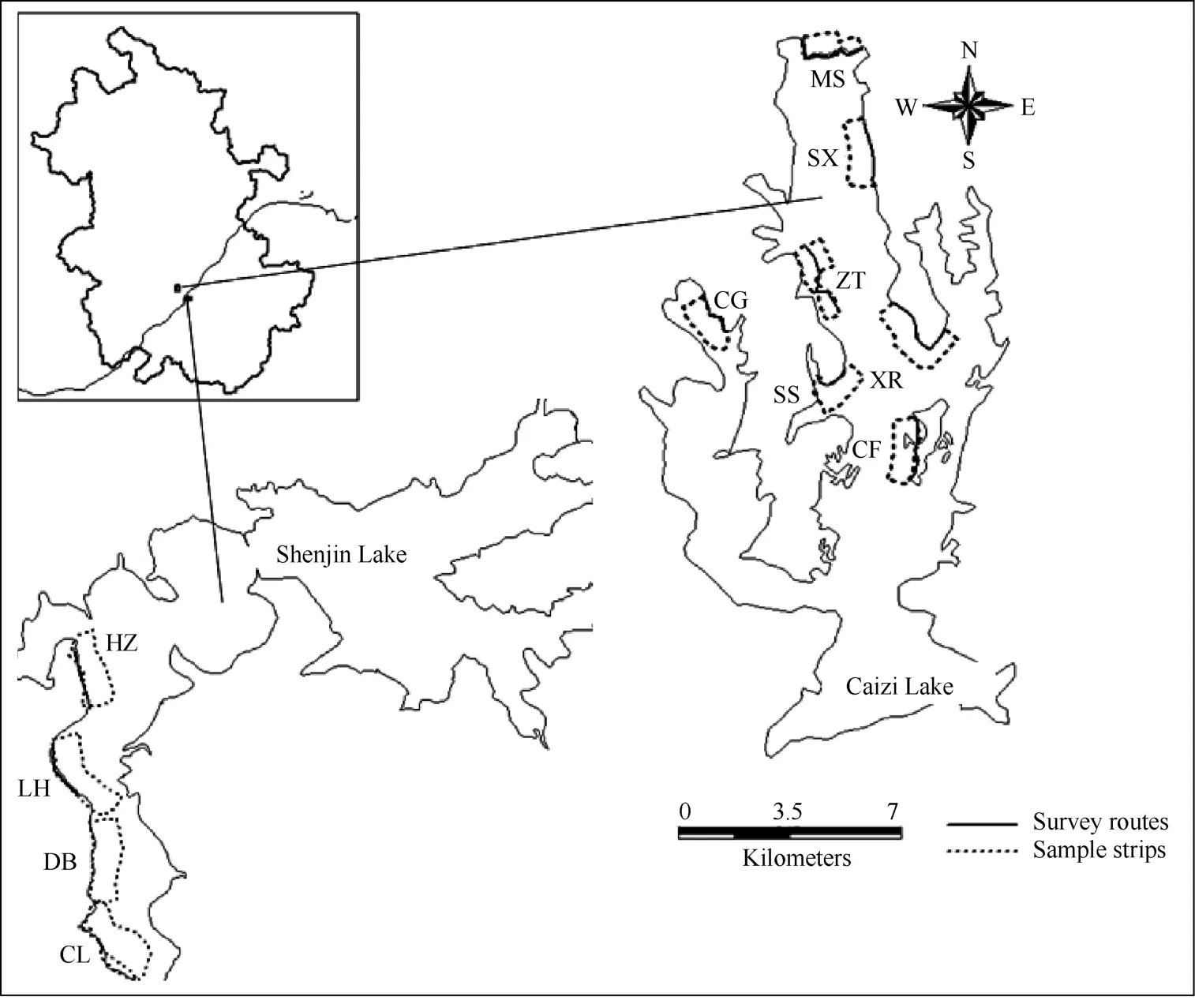
Fig. 1 Sample strips in Caizi Lake and Shengjin Lake
According to the length and observation scope of the belt transects, waterbird quantity along the transects was converted into individual quantity in unit area. The species with density greater than 10.0 ind./hm2were defined as the dominant species in the community. Statistics software (SPSS Version 17.0, http://www. spss.com) was applied to compare the differences between the main wintering communities in different wintering periods by ANOVA. Supported by PC-ORD (Version 5.0, MjM Software), cluster analysis was conducted according to species composition and density of waterbirds along the transects. The community features of the waterbirds were analyzed after grouping the research areas with the similarity between the species composition and density of waterbirds.
2 Results
2.1 Species and quantity of wintering waterbirds
During the two wintering seasons from November 2007 April 2008 and from November 2008-April 2009, respectively, a total of 119 105 waterbirds were surveyed in the 11 belt transects, amounting to 42 species belonging to7 orders of 12 families, including 15 species of Anseriformes, 12 species of Charadriiformes, three species of Ardeidae, two species of Gruiformes, two species of Ciconiidae,two species of Laridae, two species of Podicipedidae, two species of Rallidae, one species of Threskiornithidae, and one species of Phalacrocoracidae. There were a total of 47 species waterbirds in the two lakes including the other five species waterbirds outside the 11 belt transects (Appendix 1). A total of 38 waterbird species were surveyed in Caizi Lakes, and 42 species were surveyed at Shengjin Lake (Fig. 2). Six waterbird species,Ciconia nigra,Grus vipio,Platalea leucorodia,Cygnus columbianus,Anser albifrons, andAnser erythropuswere National Key Protected Wild Animals. A number of species observed are listed as endangered on the Red List of Threatened Species of IUCN, includingCiconia boycianaandGrus vipio,as well as vulnerable and nearly threatened species such asAnas falcata,Anser cygnoides, andAnser erythropus. The waterbird density in Caizi Lakes was 8.21 ind./hm2and in Shengjin Lake was 3.46 ind./hm2. According to the densities of different species, the dominant species in Shengjin Lake wereAnser cygnoides,Anser fabalisandCygnus columbianus. As well as these three species,Calidris alpinawas also dominant in Caizi Lakes.
In the early wintering period in both Caizi Lakes and Shengjin Lake, the waterbird species increased rapidly. By the end of December and the beginning of January of the following year, the number of species reached a cumulative monthly peak of 40. In the middle wintering period (January - February of the following year), the number of species of wintering waterbirds remained constant. In the later wintering period (March -April of the following year), the number of species of waterbird gradually declined. The time for each species to reach maximum varied; for example, Charadriiformes peaked in November and Anseriformes in February (Fig. 3). While peak total density occurred in January, different waterbird groups reached their density peak values at different times: Anseriformes peaked at the end of February and Charadriiforme in January (Fig 4). The densities of Anseriformes were different during the three wintering periods (n=11,F2,30=4.74,P=0.016), with the density in the early winter period showing significantly differences to the middle wintering period (P=0.07). The density of Anseriformes in midddle and late winter were different (P=0.026). The Ardeidae, Charadriiformes and Gruiformes showed no significant variation in density in the early, middle and later wintering periods (n=11,P>0.05) (Fig. 5).
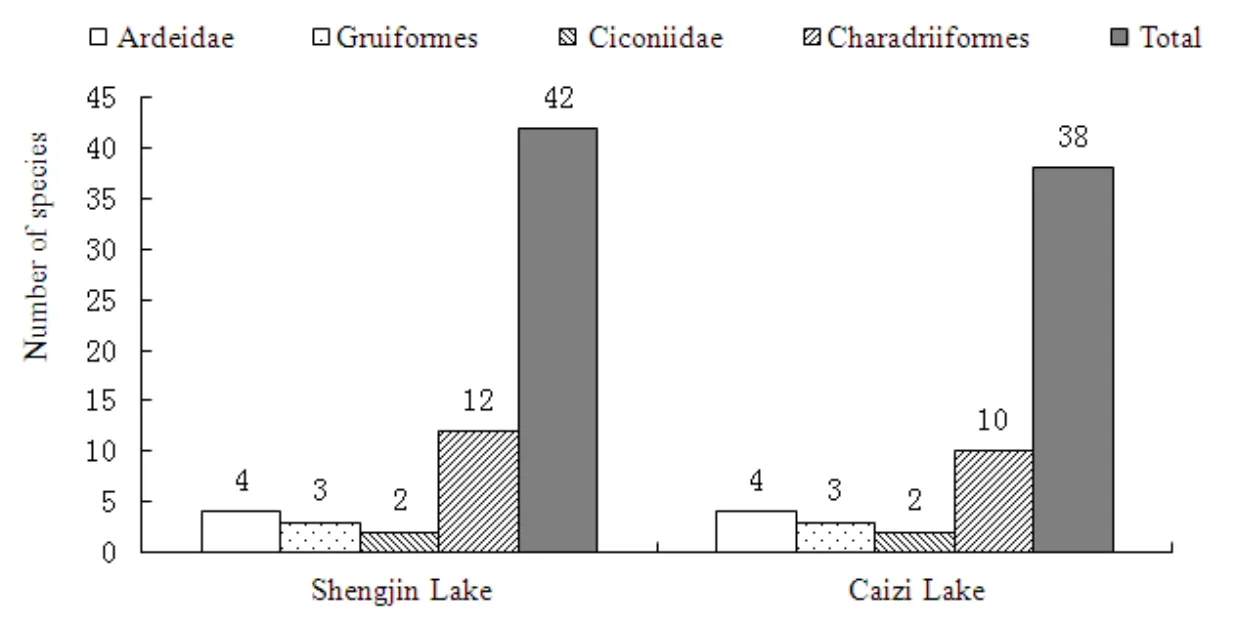
Fig. 2 The number of dominant waterbirds species in Caizi Lakes and Shengjin Lake
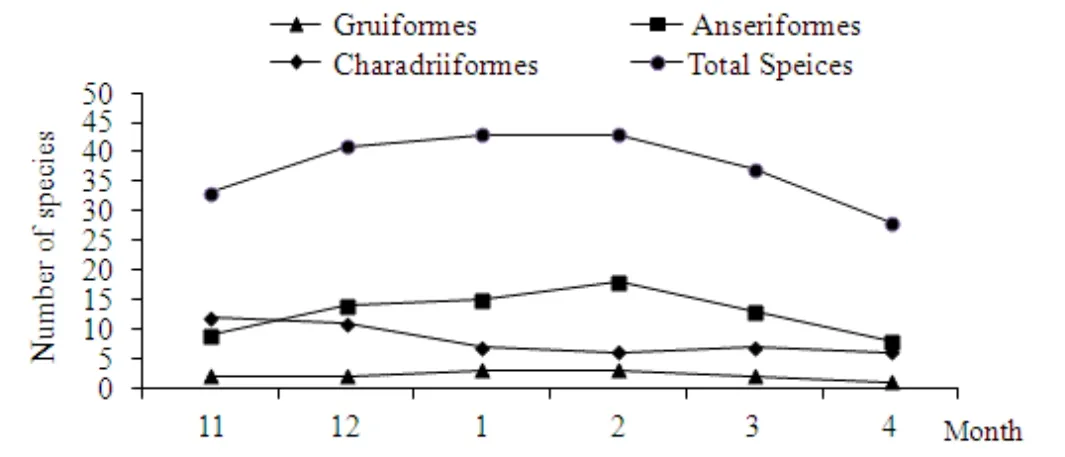
Fig. 3 Seasonal variation of dominant wintering waterbird species in Caizi Lakes and Shengjin Lake
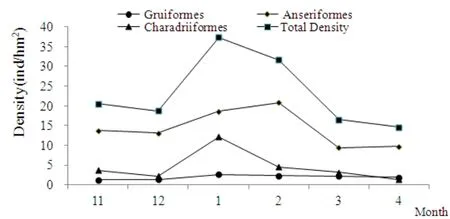
Fig. 4 Seasonal variation of the density of dominant wintering waterbird species in Caizi Lakes and Shengjin Lake
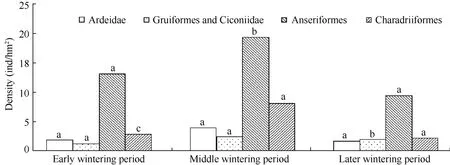
Fig. 5 The density of dominant waterbird species in the three wintering periods
2.2 Spatial distribution of wintering waterbirds
In a certain wintering period, the average waterbird density along the transects in Caizi Lakes was larger than that in Shengjin Lake, while the total number of waterbird species in Shengjin Lake was greater than that of Caizi Lakes (Tab. 1). According to species composition and density of the waterbirds, the 11 transects were divided into three groups: Group I, the five belt transects in Caizi Lakes (MS, CG, SX, XR, and CF) with many years of cage crab cultivation classified into one group; Group II, the four belt transects in Shengjin Lake (HZ, LH, DB, and CL) and one belt transect in Caizi Lakes (SS) with fish culture and polyculture of fish and crabs classified into one group; and Group III, the natural fishery area planned for development Zhutan (ZT) in Caizi Lakes (Fig. 6).
Among different groups, the average Gruiformes, Anseriformes, and Charadriiformes densities in Group III were higher than that in Groups II and I, while the density of Ardidae showed smaller changes in density among the three groups (Fig. 5).

Tab. 1 The total number of species and average density of waterbirds in Caizi Lakes and Shengjin Lake in the three wintering periods
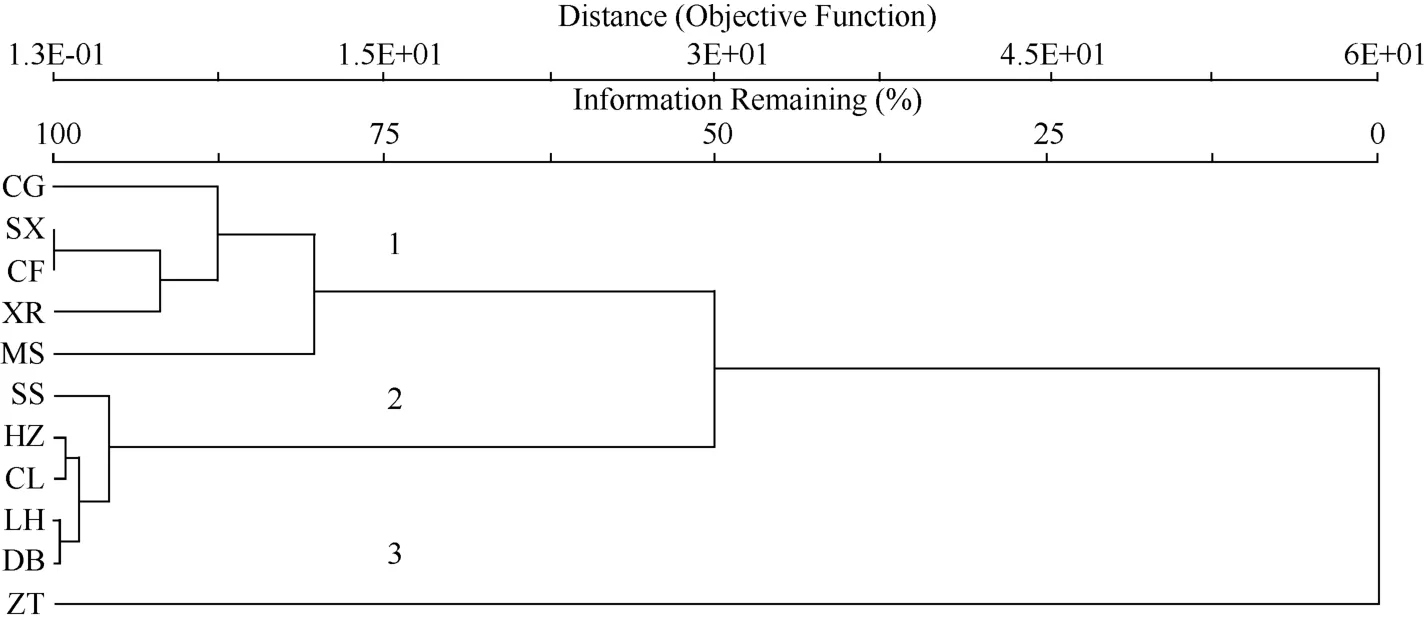
Fig. 6 Cluster analysis of spatial distribution of waterbirds in Caizi Lakes and Shengjin Lake
3 Discussion
3.1 Dynamics of species composition and quantity of wintering waterbirds
Temporary and special dynamics are important ecological characteristics of waterbird communities, which reflect seasonal change of the waterbird community and interaction between environmental factors and the waterbird community (Mai, 2006; Chen et al, 2005). The structure of waterbird communities in the stopover and wintering habitats, including river mouths, gulfs and lakes, change continuously and during the entire wintering and migration period new bird species migrate in and out constantly (Ma et al, 2009; Zhang et al, 2004). The shallow lakes in Anhui Province along the Yangtze River are located on the East Asia-Australia Flyway. Every November migratory birds begin to migrate along this flyway, with the number of species and quantity of waterbirds peaking in December (Fig. 3, Fig. 4). During this period, as the water level falls, large shoal areas are bared, which serve as ideal waterbird habitat and provide abundant food resources (Jing et al, 2007; Liu et al, 2001). The lake does not freeze so food supply is ample in an otherwise critical period for migratory waterbirds.
The temporary and spatial separation of waterbirds for wetland resources habitats provides the basis of their co-existence in winter (Gunaratne et al, 2008; Chen et al, 2005). This study showed that the quantity of Charadriiformes reaches its maximum in January while Anseriformes reached maximum in February, indicating the temporary separation of different species in wintering sites. The densities of all species declined slightly in December (Fig. 4), which was the harvesting season of aquatic products for the lakes along the middle and lower reaches of the Yangtze River. Anthropic activities such as seine fishing could have an adverse impact on wintering waterbirds. In the early wintering period, in particular, waterbirds are more sensitive to human disturbance (Jiang et al, 2007; Jing et al, 2002). Therefore, waterbird migration and human disturbance are two important factors influencing seasonal dynamics in the wintering waterbird community of the middle and lower Yangtze River floodplain lakes.
3.2 Influence of the lake exploitation pattern on wintering waterbirds
The spatial distribution of waterbirds mainly depends on the availability of resources, human disturbance, and environmental factors (Taft & Haig, 2006; Zhu et al, 2007). Cluster analysis indicated that species composition and density of the waterbirds in crab culture areas and the fish and crab polyculture areas in Caizi Lakes and Shengjin Lake were highly similar but manifested large differences compared to those in natural fishery areas (i.e., Zhutan, ZT) (Fig. 6). This difference showed that different lake aquaculture patterns exerted some influence on waterbird species composition, especially with the quantities of the Gruiformes and Anseriformes (Tab. 2). Different lake aquaculture patterns altered the hydrological structures of lakes in winter. It should be noted that hydrological conditions are critical factors determining the spatial distribution of waterbirds. By influencing the exposure degree of the lake plants and the benthos, hydrological conditions had a significant impact on food resources of wintering waterbirds, thus determining the waterbirds’ spatial composition (Thomas et al, 2006; Alejandro et al, 2007). The density distribution of Gruiformes in the fish and crab culture areas differed from that in the natural fishery areas (Tab. 2), probably due to the long-term highdensity fishery aquaculture causing deterioration of the water environment, aqueous vegetation and food resources, which led to the change in quantity distribution of Gruiformes (Zhao et al, 2002). However, the wading Ardeidae species were less affected by vegetation degradation caused by various fishery patterns as they mainly feed on small fish. Anseriformes feed on the benthos of large size and plant rhizomes, and usually chose the patchy and discontinuous small water profundal zones as feeding sites. When soil dams were constructed in the shallow lakes, the habitats were transformed into patches, while maintaining certain water depth locally. While such a situation may benefit the Anseriformes, after the high-density aquaculture ofEriocheir sinensis, vast quantities of benthos were consumed and food resources were reduced. Such lake aquaculture patterns may be the critical reason for the significant influence on Anseriformes (Hakan & Marcel, 2008; Zhao, et al, 2008).

Tab. 2 The dominant waterbird density in lake zones with different fishery patterns
Shengjin Lake and Caizi Lakes are important wintering sites for migratory birds along the Yangtze River, and these areas are experiencing increasing environmental pressure. On the whole, the waterbird densities in the two lakes showed little difference; however, in local lake areas with different aquaculture patterns, dominant species of wintering waterbird communities, such as Gruiformes and Anseriformes, have been greatly influenced. Therefore, lake fishery patterns are highly important to the conservation of wintering waterbirds and the sustainable exploitation of lake wetlands.
Acknowledgements:We wish to express our thanks to Mr. Hong Zhang of the Anqing Wetland Waterbird Nature Reserve and Yuanqi Cheng, Director General of Administration Bureau of Sengjin Lake National Nature Reserve for their substantial support in fieldwork.
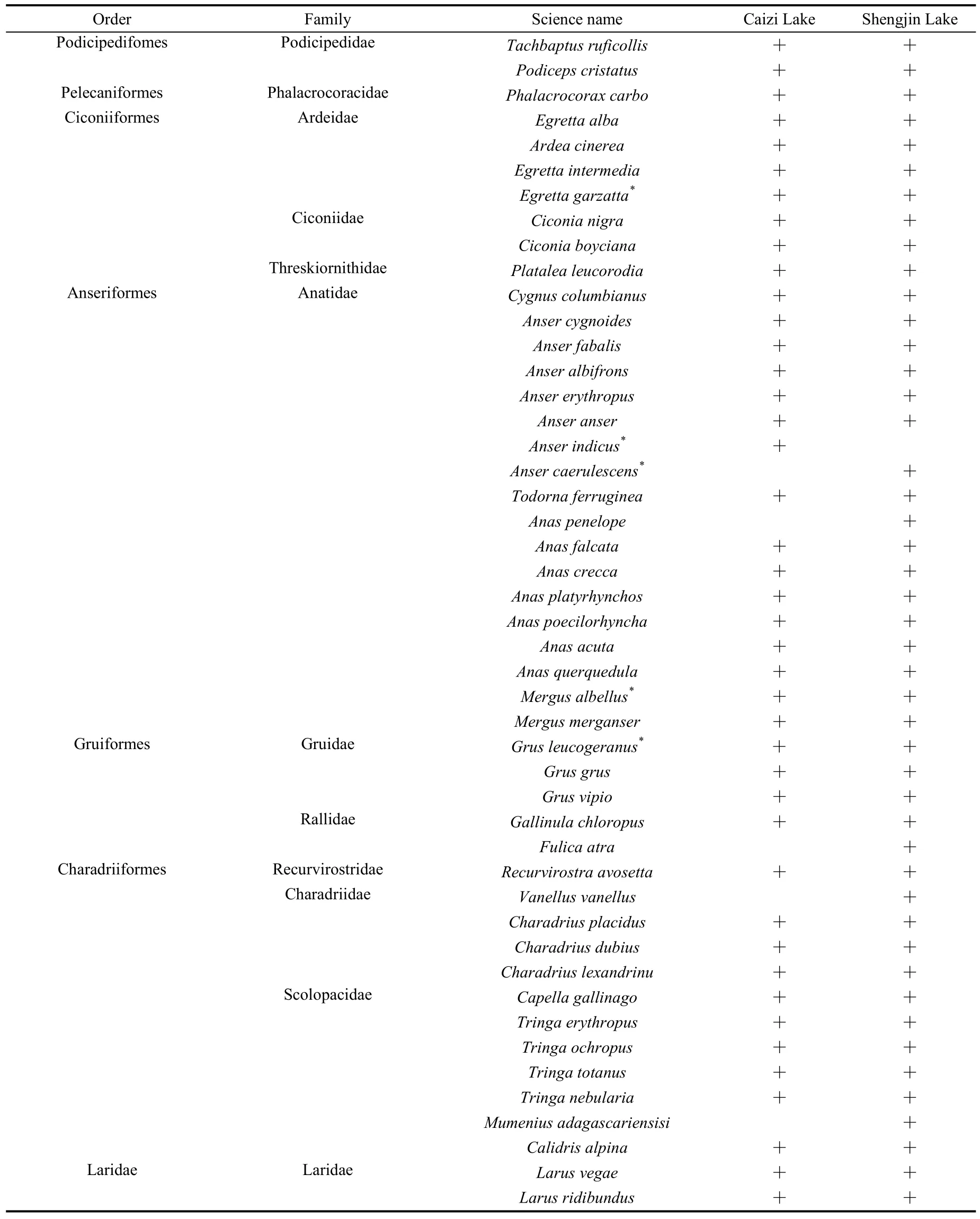
Appendix 1 The distribution of Waterbirds in the 11 belt transects of the two lakes
Alejandro DC, Juanp I, Domingoa G, Domingoa.GA, Aliciah E, Oscaro I. 2007. Waterbird response to changes in habitat area and diversity generated by rainfall in a SW Atlantic coastal lagoon[J].Waterbirds, 30: 541-553.
Barter M, Chen LW, Cao L, Lei G. 2004. Waterbird Survey of the Middle and Lower Yangtze River floodplain in late January and February 2004[M], Beijing: China Forestry Publishing House, 102.
Benjamin M, Vallejo J, Alexander BA, Perry SO. 2009.The distribution, abundance and diversity of birds in Manila's last greenspaces[J].Lands Urb Plan, 89: 75-85.
Chen XW, Li BL, Thomas AS, Tennant T, Rotenberry JT, Allen MF. 2005. Spatial structure of multispecies distributions in southern California, USA[J].Biol Conserv, 124: 169-175.
Erwin RM. 1996. Dependence of waterbirds and shorebirds shallowwater habitats in the Mid-Atlantic coastal region: An ecological profile and management recommendations [J].Estuaries Coartra, 19: 213-219.
Fang JY, Wang ZH, Zhao SQ, Li YK, Tang ZY, Yu D, Ni LY, Liu HZ, Xie P, Da LG, Li ZQ, Zheng CY. 2006. Biodiversity changes in the lakes of the Central Yangtze[J].Front Ecol Environ,4: 369-377.
Gunaratne AM, Jayakody S, Bambaradeniya CNB. 2008. Spatial distribution of aquatic birds in Anavilundawa Ramsar wetland sanctuary in Sri Lanka[J].Biol Invasions, 11: 951-958.
Hakan S, Marcel K. 2008. Swan foraging shapes spatial distribution of two submerged plants, favouring the preferred prey species[J].Oecologia, 156: 569-576.
Jiang HX, Xu WB , Qian FW, Chu GZ. 2007. Impact of habitat evolution and human disturbance on wintering water birds in Shengjin Lake of Anhui Province, China[J].Chn J Appl Ecol, 18(8): 1832-1836.
Jing K, Tang SM, Chen JK, and Ma ZJ. 2002. Wintering ecology of the Hooded Crane in the eastern tideland of Chongming Island[J].Chn J Zool,37(6): 29-34.
Jing K, Ma ZJ, Li B, Li JH, Chen JK .2007. Foraging strategies involved in habitat use of shorebirds at the intertidal area of Chongming Dongtan, China[J].Ecol Res,22: 559-570.
Joseph AB, Myers WL. 2005. Associations between avian functional guild response and regional landscape properties for conservation planning.Ecol Indicators, 5: 33-48.
Liu ZY, Xu WB, Wang QS, Shi KC, Xu JS, Yu GQ. 2001. Environmental carrying capacity for over-wintering Hooded Cranes in Shengjin Lake[J].Resour Environ Yangtze Basin, 10(5): 454-459.
Ma JH, Liu Y, Lei JY. 2006. Methods for Bird Surveys - A Pracatical Handbook[M]. Hong Kong: Bird Watching Society.
Ma ZJ, Wang Y, Gan XJ, Li B, Cai YT, Chen JK. 2009. Waterbird population changes in the wetlands at Chongming Dongtan in the Yangtze River Estuary, China[J].Environ Manage, 43: 1187-1200.
Mai Y. 2006. Environmental factors and spatial scale influence shorebirds' responses to human disturbance[J].Biol Conserv,128: 47-54.
Paillissona JM, Reeber S, Mariona L. 2002. Bird assemblages as bioindicators of water regime management and hunting disturbance in natural wet grasslands[J].Biol Conserv, 106: 115-127.
Taft OW, Haig SM. 2006. Importance of wetland landscape structure to shorebirds wintering in an agricultural valley[J].Landsc Ecol, 21: 169-184.
Xu LL, Xu WB, Sun QY, Zhou ZZ, Shen J, Zhao XX. 2008. Flora and vegetation in Shengjin Lake [J].J Wuhan Botanical Res, 27(3): 264-270.
Zhang SP, Zhang ZW, Xu JL, Sun QH, Liu DP.2004. Seasonal changes and interspecific correlation among the migratory waterbird communities in Tian Jin[J].Acta Ecol Sin, 24(4): 666-673.
Zhao JX, Liu H, Zhang QL. 2008. Spatial patterns for the distribution of winter waterbirds in the aquaculture ponds of Chongming Dongtan, Shanghai [J].Zool Res, 29(2): 212-218.
Zhao YY, Ma ZJ, Chen JK. 2002. Food habits of hooded crane (Grus monacha) in winter at the East Tidelands of Chongming Island[J].J Fudan Univ:Nat Sci, 41(6): 509-613.
Zhou B, Zhou LZ, Chen JY, Cheng YQ, Xu WB. 2010. Diurnal timeactivity budgets of wintering hooded cranes (Grus monacha) in Shengjin Lake, China[J].Waterbirds, 33: 110-115.
Zhu J, Jing K, Gan XJ, Ma ZJ. 2007. Food supply in intertidal area for shorebirds during stopover at Chongming Dongtan, China[J],Acta Ecol Sin, 27: 2149-2159.
Zhu WZ, Zhou LZ. 2010. Biodiversity and Conservation in Anqing Floodplain Wetlands[M]. Hefei: Hefei University of Technology Press.
安徽沿江两个浅水型湖泊越冬水鸟的季节动态
陈锦云1,2, 周立志1,*,周 波1,许仁鑫1,朱文中3, 徐文彬4
[1.安徽大学资源与环境工程学院安徽大学生物多样性与湿地生态研究所,安徽 合肥230601; 2.淮南师范学院 生命科学系,安徽 淮南232001; 3.安徽安庆沿江湿地自然保护区,安徽 安庆246001; 4.升金湖国家级自然保护区,安徽 东至247200]
安徽沿江浅水型通江湖泊湿地是东亚—澳大利亚迁徙水鸟的重要越冬地和停歇地。近年来,高强度的渔业养殖使湿地严重退化,对越冬水鸟构成威胁。为了解湿地变化对越冬迁徙水鸟的影响,2007年11—2008年4月和2008年11月—2009年4月, 对安徽菜子湖和升金湖11个样带内越冬水鸟的种类、数量及空间分布进行了调查,并分析了湖泊渔业模式对水鸟分布的影响。两个湖泊共统计到越冬水鸟7目12科43种。其中, 菜子湖群38种, 密度为8.2 ind./hm2; 升金湖42种, 密度为3.5 ind./hm2, 优势种为鸿雁(Anser cygnoides)、豆雁(Anser fabalis)、小天鹅(Cygnus columbianus)和黑腹滨鹬(Calidris alpina)。越冬水鸟种类和数量在12月底—次年1月上旬达到最大值, 但不同类型越冬群最大数量出现的具体时期有所不同。根据水鸟组成的聚类分析, 可将水鸟栖息地分为三组。水鸟的分布与渔业模式有关,在自然捕捞区, 鹤类、雁鸭类和鸻鹬类密度较大,在围网养殖区密度较小,而鹭类的密度在各湖区变化都较小。本研究结果提示, 发展可持续渔业对于长江中下游浅水湖泊湿地越冬水鸟资源的保护具有重要意义。
2011-02-11;接受日期:2011-07-08
陈锦云(1974—),男,博士研究生,主要从事生物地理学和生物多样性保护研究
越冬水鸟; 群落多样性; 季节动态; 养殖扰动; 菜子湖; 升金湖
Q958.15; Q959.7
A
0254-5853-(2011)05-0540-09
10.3724/SP.J.1141.2011.05540
date: 2011-02-11; Accepted date: 2011-07-08
s: Supported partly by the National Natural Science Foundation of China (30870317); EU-China Biodiversity Programme (00056783); Anhui Academic and Technical Leader Fund
*Corresponding author (通信作者), E-mail: zhoulz@ahu.edu.cn
猜你喜欢
杂志排行
Zoological Research的其它文章
- 白眉山鹧鸪冬季觅食地选择
- Association of RELN promoter SNPs with schizophrenia in the Chinese population
- Decreased contrast sensitivity of visual cortical cells to visual stimuli accompanies a reduction of intracortical inhibition in old cats
- Complete mitochondrial genome of the laced fritillary Argyreus hyperbius (Lepidoptera: Nymphalidae)
- Possible genetic reproductive isolation between two tilapiine genera and species: Oreochromis niloticus and Sarotherodonmelanotheron
- A new blind loach species, Triplophysa huanjiangensis (Teleostei: Balitoridae), from Guangxi, China
